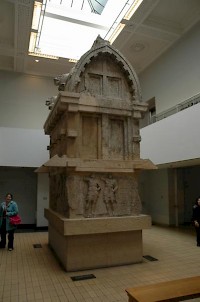Xanthus, Tomb of Payava
Q5853357Xanthus: town in western Lycia; its original name was Arňna, its modern name is Kınık.
Tomb of Payava

A famous Lycian tomb from Xanthus, made in the classical age, is the tomb of Payava, which can today be seen in the British Museum. It dates back to the first quarter of the fourth century BCE and combines Greek and oriental motifs.
Among the Greek motifs are Payava and a companion, wearing cuirasses and cloaks; on the opposite side, you can see a Greek athlete and a man who may be his trainer. On the other hand, on one of the long sides, we can see a satrap receiving several people. Lions and sphinxes are common motifs from Lycia itself, while the hunting scene on the "roof" of this tomb can belong to any culture.
This combination of motifs can also be recognized in the Nereid Monument, which was also made in the first quarter of the fourth century BCE.
 Xanthus, Payava's tomb, Relief |